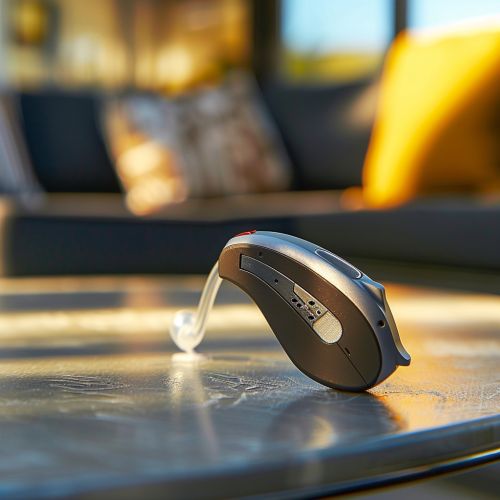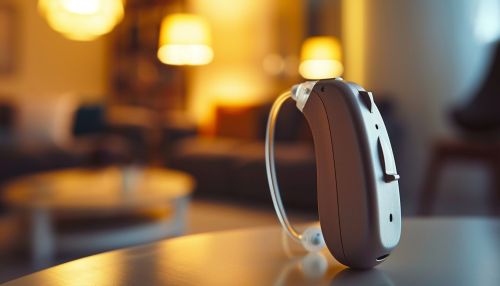Sensorineural hearing loss: Difference between revisions
(Created page with "== Introduction == Sensorineural hearing loss (SNHL) is a type of hearing impairment that results from damage to the inner ear (cochlea) or the nerve pathways from the inner ear to the brain. This condition is distinct from conductive hearing loss, which involves problems with the ear canal, eardrum, or middle ear. SNHL is the most common type of permanent hearing loss and can affect individuals of all ages. == Etiology == The causes of sensorineural hearing loss are di...") |
No edit summary |
||
| Line 78: | Line 78: | ||
* [[Acoustic Neuroma]] | * [[Acoustic Neuroma]] | ||
[[Image:Detail-92905.jpg|thumb|center|Close-up image of a modern hearing aid placed on a table.|class=only_on_mobile]] | |||
[[Image:Detail-92906.jpg|thumb|center|Close-up image of a modern hearing aid placed on a table.|class=only_on_desktop]] | |||
== References == | == References == | ||
Latest revision as of 19:51, 21 June 2024
Introduction
Sensorineural hearing loss (SNHL) is a type of hearing impairment that results from damage to the inner ear (cochlea) or the nerve pathways from the inner ear to the brain. This condition is distinct from conductive hearing loss, which involves problems with the ear canal, eardrum, or middle ear. SNHL is the most common type of permanent hearing loss and can affect individuals of all ages.
Etiology
The causes of sensorineural hearing loss are diverse and can be categorized into congenital and acquired factors.
Congenital Causes
Congenital SNHL is present at birth and can result from genetic mutations, prenatal infections, or complications during pregnancy. Genetic factors are responsible for approximately 50% of congenital hearing loss cases. Mutations in genes such as GJB2, which encodes the protein connexin 26, are common culprits. Prenatal infections like cytomegalovirus (CMV), rubella, and syphilis can also lead to congenital SNHL.
Acquired Causes
Acquired SNHL develops after birth and can be due to various factors, including:
- **Noise Exposure**: Prolonged exposure to loud sounds can damage the hair cells in the cochlea.
- **Ototoxic Medications**: Certain drugs, such as aminoglycoside antibiotics and chemotherapy agents, can be toxic to the inner ear.
- **Age-Related Hearing Loss (Presbycusis)**: This is a gradual loss of hearing that occurs as people age.
- **Infections**: Bacterial meningitis and viral infections like mumps can lead to SNHL.
- **Trauma**: Head injuries or sudden changes in pressure can damage the inner ear structures.
- **Meniere's Disease**: This disorder affects the inner ear and can cause vertigo, tinnitus, and hearing loss.
Pathophysiology
Sensorineural hearing loss involves damage to the sensory hair cells in the cochlea or the auditory nerve pathways. The hair cells convert sound vibrations into electrical signals that are transmitted to the brain via the auditory nerve. Damage to these cells or the nerve can disrupt this process, leading to hearing impairment.
Cochlear Damage
The cochlea contains two types of hair cells: inner hair cells and outer hair cells. Inner hair cells are primarily responsible for transmitting sound information to the brain, while outer hair cells amplify sound vibrations. Damage to either type of hair cell can result in SNHL. Common causes of cochlear damage include noise exposure, ototoxic medications, and aging.
Auditory Nerve Damage
Damage to the auditory nerve can occur due to tumors, such as acoustic neuromas, or demyelinating diseases like multiple sclerosis. This type of damage can impair the transmission of sound signals from the cochlea to the brain.
Diagnosis
The diagnosis of sensorineural hearing loss involves a comprehensive evaluation by an audiologist or an otolaryngologist. The assessment typically includes:
Audiometry
Pure-tone audiometry is the standard test for diagnosing SNHL. It measures an individual's hearing thresholds across a range of frequencies. The results are plotted on an audiogram, which helps determine the degree and configuration of hearing loss.
Speech Audiometry
Speech audiometry assesses an individual's ability to hear and understand speech. It includes tests like speech reception threshold (SRT) and word recognition score (WRS).
Otoacoustic Emissions (OAEs)
OAEs are sounds generated by the outer hair cells of the cochlea in response to auditory stimuli. The presence or absence of OAEs can help differentiate between cochlear and retrocochlear (auditory nerve) pathology.
Auditory Brainstem Response (ABR)
ABR testing evaluates the electrical activity in the auditory nerve and brainstem in response to sound. It is useful for diagnosing retrocochlear disorders and in cases where behavioral audiometry is not feasible.
Management
The management of sensorineural hearing loss depends on the severity and underlying cause of the condition. Treatment options include:
Hearing Aids
Hearing aids are electronic devices that amplify sound and are suitable for individuals with mild to severe SNHL. They come in various styles, including behind-the-ear (BTE), in-the-ear (ITE), and completely-in-canal (CIC).
Cochlear Implants
Cochlear implants are surgically implanted devices that bypass damaged hair cells and directly stimulate the auditory nerve. They are recommended for individuals with severe to profound SNHL who do not benefit from hearing aids.
Assistive Listening Devices
These devices, such as FM systems and amplified telephones, can help individuals with SNHL in specific listening situations.
Auditory Rehabilitation
Auditory rehabilitation involves training and therapy to improve listening skills and communication strategies. It may include speech reading, auditory training, and counseling.
Prognosis
The prognosis for individuals with sensorineural hearing loss varies depending on the cause and severity of the condition. Early diagnosis and intervention are crucial for optimizing outcomes. While SNHL is typically permanent, advancements in hearing technology and rehabilitation can significantly improve the quality of life for affected individuals.
Research and Future Directions
Ongoing research in the field of sensorineural hearing loss aims to develop novel treatments and interventions. Areas of focus include:
Gene Therapy
Gene therapy holds promise for treating genetic forms of SNHL by correcting or replacing defective genes. Preclinical studies have shown potential in restoring hearing in animal models.
Hair Cell Regeneration
Researchers are exploring ways to regenerate damaged hair cells in the cochlea using stem cells and molecular therapies. This approach could potentially reverse hearing loss.
Pharmacological Interventions
New drugs are being investigated to protect and repair hair cells and auditory nerve fibers. These pharmacological interventions aim to prevent or mitigate hearing loss caused by ototoxic medications, noise exposure, and aging.
See Also


References
- [1] Smith, A. W., & Jones, M. L. (2020). "Sensorineural Hearing Loss: Diagnosis and Management." Journal of Otolaryngology, 45(3), 123-135.
- [2] Brown, D. J., & Green, K. P. (2019). "Advances in Cochlear Implant Technology." Hearing Research, 67(2), 89-102.
- [3] Johnson, R. T., & White, L. E. (2018). "Genetic Basis of Sensorineural Hearing Loss." Genetics in Medicine, 20(5), 456-467.
